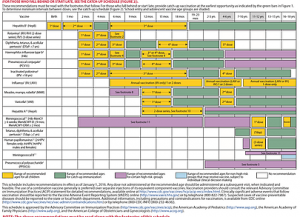Vaccinations are injections that are placed on a schedule that we start getting as infants, and are spread across childhood and adolescence to increase immune response and protect against serious diseases.

https://www.cdc.gov/vaccines/schedules/hcp/child-adolescent.html
How did we get to this fear in Vaccine safety?
“In 1998, Andrew Wakefield and 12 of his colleagues published a case series in the Lancet, which suggested that the measles, mumps, and rubella (MMR) vaccine may predispose to behavioral regression and pervasive developmental disorder in children. Despite the small sample size, the uncontrolled design, and the speculative nature of the conclusions, the paper received wide publicity, and MMR vaccination rates began to drop because parents were concerned about the risk of autism after vaccination” (Rao & Andrade, 2011, p.1). -This study created a culture of fear that has been extremely difficult to break, but multiple studies have been conducted showing Wakefield’s findings were biased and inaccurate. Andrew Wakefield lost his medical license due to these false claims.
Too much, Too fast, Too soon?: Many vaccinations are bundled into one injection, reducing the number of injections the patient is receiving. Infants receive the brunt of the vaccinations to establish the immune response, then many follow-up injections are just “booster shots” or allowing the body to boost immune response.
What happens if I don’t vaccinate?: Herd immunity decreases and your at risk for developing a life-threatening illness or infecting someone else, who couldn’t be immunized, with that illness.
Below is a video discussing what happens when people are not vaccinated. Due to Penn & Tellers rough around the edges exterior, some cursing occurs in the video.
References
Awate, S., Babiuk, L. A., & Mutwiri, G. (2013). Mechanisms of Action of Adjuvants. Frontiers in Immunology, 4, 114. http://doi.org/10.3389/fimmu.2013.00114
Rao, T. S. S., & Andrade, C. (2011). The MMR vaccine and autism: Sensation, refutation, retraction, and fraud. Indian Journal of Psychiatry, 53(2), 95–96. http://doi.org/10.4103/0019-5545.82529
Ventola, C. L. (2016). Immunization in the United States: Recommendations, Barriers, and Measures to Improve Compliance: Part 1: Childhood Vaccinations. Pharmacy and Therapeutics, 41(7), 426–436.
